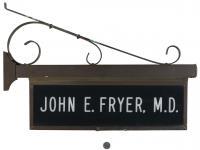PHILADELPHIA, PA—The Historical Society of Pennsylvania (HSP) is pleased to announce the launch of its latest digital history project, Anonymous No More: John Fryer, Psychiatry, and the Fight for LGBT Equality.
In the history of the fight for LGBT equality, psychiatry has played a central, and fraught, role. For decades, the psychiatric profession officially classified homosexuality as a mental illness. Individuals who sought psychiatric treatment were often counseled to give up their sexual orientation; at the extremes, members of this community were "treated" with lobotomies. For good reason, then, LGBT activists have often imagined psychiatry as the enemy. Users of this website are invited to consider how this narrative changes—and how it stays the same—when examined through the lens of one man: Philadelphia psychiatrist Dr. John Fryer, who was also gay.

Dr. Henry Anonymous [John Fryer] speech to the American Psychiatric Association original draft, 1972. From the John E. Fryer papers [3465]
In 2014, HSP and playwright Ain Gordon began An Artist Embedded, a collaboration to develop an innovative stream of historical interpretation illuminating intersections between history and contemporary life. Over the next two years, Gordon combed through the papers of John Fryer (1937–2003), whose papers were donated to HSP after his death. This research contributed to Gordon’s play, the 217 Boxes of Dr. Henry Anonymous, which was performed at the Painted Bride Art Center in May 2016.

The set of Ain Gordon's play, 217 Boxes of Dr. Henry Anonymous. Photo by Vincent Fraley

Dr. Anonymous [John Fryer] delivering his speech at the 1972 annual meeting of the American Psychiatric Association. Image courtesy of the New York Public Library.
Basing a play on a historical figure inevitably raises questions. The first has to do with selectivity. Choosing to tell one story necessarily leaves others out. John Fryer was one part of the movement for gender and sexual equality, positioned by his personal history and his considerable privilege to address one aspect of discrimination. The Stonewall riots, perhaps the best-known event associated with this movement, were largely started by trans activists and activists of color. Sadly, their contributions have been erased through selective memory and cultural representation, including the recent film Stonewall (2015).

Dr. Henry Anonymous [John Fryer] speech to the American Psychiatric Association original draft, 1972. From the John E. Fryer papers [3465]
To avoid perpetuating this invisibility, we must contend with the language we use to talk about different groups and individuals. We aim here to be specific, inclusive, and historically accurate. In the 1960s and 1970s, the era in which most of the documents included here were produced, people did not identify as members of an LGBTQ+ community. To use just one example, the term “queer” was at this time derogatory; it had not yet been reclaimed by activists as a positive marker of identity. Thus, this term is generally restricted here to discussions of contemporary issues. Users may notice our use of the phrases “gender and sexual minorities” and “movement for gender and sexual equality.” While reflecting presentist understandings of discrimination and identity, these phrases acknowledge that Fryer was a part of something bigger than himself without imposing specific labels on people who would not have identified with them. Where relevant and appropriate, we do use specific terminology—gay men, gay psychiatrists, and gay men and lesbians, for example. For many writers, these choices are personal and political as well as historical, and we have preserved essayists’ chosen language when it differs from our own. For a broader look at this subject, see Pennsylvania Legacies, "Pennsylvania Pride: LGBT Histories of the Commonwealth."

HSP staffers test out the new crosswalks outside the historic library and archive located in the heart of Philadelphia's Gayborhood, 2015. Photo by Sessalli Obasuyi.
The second question has to do with truth and fiction. The three characters in the 217 Boxes of Dr. Henry Anonymous—Alfred A. Gross, Katherine Luder, and Ercel Fryer—were real people who knew John Fryer, but their monologues convey a certain time, place, and set of circumstances—the ways the legal system discriminated against gay men, or the early years of the AIDS crisis—more than the experiences of these particular individuals. Gordon invented his characters’ inner thoughts and feelings, but the social, political, and cultural context they describe is accurate. Additionally, some of the script—most importantly excerpts of Fryer’s speech, as read by his father, Ercel—was taken directly from manuscript material. Over the course of the grant, HSP hosted several programs that addressed these questions, which Gordon also speaks about here.

Photocopy of Philadelphia Gay News' Dr. Anonymous [John Fryer] article, 2002. From the John E. Fryer papers [3465]
Major support for An Artist Embedded was provided by the Pew Center for Arts & Heritage, with additional support from HSP.

